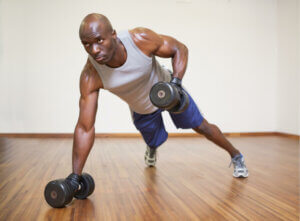Anaerobic Exercise: Health Benefits and Risks

Can anaerobic exercise provide you with health benefits? It’s always relegated to a space behind aerobic exercise, which all cardiologists and nutritionists recommend to complement a balanced diet. But anaerobic practice can be extremely positive.
While there’s a lot of research out there around the use of oxygen in sports and how it improves cardiovascular health and metabolism, less is known about anaerobic exercises. Although there are some risks inherent in its practice, it can also be beneficial when it’s done in a safe way.
What is anaerobic exercise?
Our cells need oxygen for their internal processes. That’s why breathing and the circulatory apparatus are in charge of distributing this gas throughout all of the body’s tissues. This helps the body take advantage of it and convert it to energy.
In particular, the muscle possesses a special sensibility to the existence of certain levels of oxygen that make it up. When it’s insufficient, they become depleted. In these situations, they don’t have a way to transform nutrients into energy within the cells.
Although it may seem contradictory to say that anaerobic exercise is done without oxygen, the truth is that what it produces is a kind of “debt.” The muscles can carry out a series of movements, contractions, and relaxations that demand more gas than what circulates. But this remains “on account” to be settled in the immediate future.
All exercises begin as aerobic. That’s to say that they increase breathing and circulation at the beginning. This supplies the demands of oxygen to the tissues that are being used. However, in certain exercises, after a time, these demands exceed what they’re able to take in with the breath and the muscles begin to generate energy with the deposits. This means that the oxygen will be replenished as the effort subsides.
This means that the “anaerobic “comes from the generation of oxygen debt. The body will limit activity to exhaustion and will require its systems to replenish the gas that is consumed at that moment.

Types of anaerobic exercise
In the traditional sense, anaerobic exercise is done in order to gain muscle mass through strength training. The gym is the place where this is done. W can divide these exercises into three main groups:
- Calisthenics: these are the exercises that use your own body weight. You use your own bodyweight to raise itself or sustain itself against resistance. There’s no apparatus needed.
- Strength machines: here, the variety is enormous. There are many machines that focus on specific muscle groups or anatomical areas.
- Free weights: lifting weights, for example, is a form of free weights where they’re raised without the use of any machine. It’s not only an exercise that develops strength, but also balance and joint mobility.
Health benefits of anaerobic exercise
If we had to sum up the benefits of anaerobic exercise for human health, the main points would be the following:
- Muscular resistance improvement: muscles tend to become tired when they go without sufficient oxygen, according to many studies. When you frequently do anaerobic exercises, the tissue begins to adapt itself to this situation. This will lengthen the time that the muscles can spend in contraction or relaxation while generating a gas debt. This will reduce fatigue in the long term.
- Muscular hypertrophy: as a new study indicates, anaerobic exercise increases muscle mass. This is associated with medical studies and an increase in quality of life in old age. This is due to the fact that it reduces the sarcopenia with the passage of time.
- Reduction of body fat: all exercise is helpful in reducing body weight. By reducing body fat, you eliminate one of the most dangerous cardiovascular risk factors: cholesterol and triglycerides.

Risks of exercising without oxygen
The risks associated with anaerobic exercise are closely linked to the previous state of health of the person who is practicing it. Someone in old age isn’t the same as a young person with no illnesses.
Injuries from this exercise aren’t small. Muscles can be pushed to levels that are above their abilities.
If this happens, there can be major contractions, tears, or strains in the muscles. This is why it’s important to respect the maximum load that is achievable for your body and to progress carefully. This way, your tissues will be able to adapt to a greater range.
Plan your exercise carefully
For people of advanced age, you have to keep in mind that your joints and muscle cells are also in their own process of aging. This means that their response to a lack of oxygen won’t be immediate. An oxygen debt in a person over 60 years old needs to be dealt with carefully.
In any case, this isn’t an absolute contraindication. As much as possible, it’s always best to get a specialist to evaluate your training plan. This can increase security and help you avoid adverse effects.
Can anaerobic exercise provide you with health benefits? It’s always relegated to a space behind aerobic exercise, which all cardiologists and nutritionists recommend to complement a balanced diet. But anaerobic practice can be extremely positive.
While there’s a lot of research out there around the use of oxygen in sports and how it improves cardiovascular health and metabolism, less is known about anaerobic exercises. Although there are some risks inherent in its practice, it can also be beneficial when it’s done in a safe way.
What is anaerobic exercise?
Our cells need oxygen for their internal processes. That’s why breathing and the circulatory apparatus are in charge of distributing this gas throughout all of the body’s tissues. This helps the body take advantage of it and convert it to energy.
In particular, the muscle possesses a special sensibility to the existence of certain levels of oxygen that make it up. When it’s insufficient, they become depleted. In these situations, they don’t have a way to transform nutrients into energy within the cells.
Although it may seem contradictory to say that anaerobic exercise is done without oxygen, the truth is that what it produces is a kind of “debt.” The muscles can carry out a series of movements, contractions, and relaxations that demand more gas than what circulates. But this remains “on account” to be settled in the immediate future.
All exercises begin as aerobic. That’s to say that they increase breathing and circulation at the beginning. This supplies the demands of oxygen to the tissues that are being used. However, in certain exercises, after a time, these demands exceed what they’re able to take in with the breath and the muscles begin to generate energy with the deposits. This means that the oxygen will be replenished as the effort subsides.
This means that the “anaerobic “comes from the generation of oxygen debt. The body will limit activity to exhaustion and will require its systems to replenish the gas that is consumed at that moment.

Types of anaerobic exercise
In the traditional sense, anaerobic exercise is done in order to gain muscle mass through strength training. The gym is the place where this is done. W can divide these exercises into three main groups:
- Calisthenics: these are the exercises that use your own body weight. You use your own bodyweight to raise itself or sustain itself against resistance. There’s no apparatus needed.
- Strength machines: here, the variety is enormous. There are many machines that focus on specific muscle groups or anatomical areas.
- Free weights: lifting weights, for example, is a form of free weights where they’re raised without the use of any machine. It’s not only an exercise that develops strength, but also balance and joint mobility.
Health benefits of anaerobic exercise
If we had to sum up the benefits of anaerobic exercise for human health, the main points would be the following:
- Muscular resistance improvement: muscles tend to become tired when they go without sufficient oxygen, according to many studies. When you frequently do anaerobic exercises, the tissue begins to adapt itself to this situation. This will lengthen the time that the muscles can spend in contraction or relaxation while generating a gas debt. This will reduce fatigue in the long term.
- Muscular hypertrophy: as a new study indicates, anaerobic exercise increases muscle mass. This is associated with medical studies and an increase in quality of life in old age. This is due to the fact that it reduces the sarcopenia with the passage of time.
- Reduction of body fat: all exercise is helpful in reducing body weight. By reducing body fat, you eliminate one of the most dangerous cardiovascular risk factors: cholesterol and triglycerides.

Risks of exercising without oxygen
The risks associated with anaerobic exercise are closely linked to the previous state of health of the person who is practicing it. Someone in old age isn’t the same as a young person with no illnesses.
Injuries from this exercise aren’t small. Muscles can be pushed to levels that are above their abilities.
If this happens, there can be major contractions, tears, or strains in the muscles. This is why it’s important to respect the maximum load that is achievable for your body and to progress carefully. This way, your tissues will be able to adapt to a greater range.
Plan your exercise carefully
For people of advanced age, you have to keep in mind that your joints and muscle cells are also in their own process of aging. This means that their response to a lack of oxygen won’t be immediate. An oxygen debt in a person over 60 years old needs to be dealt with carefully.
In any case, this isn’t an absolute contraindication. As much as possible, it’s always best to get a specialist to evaluate your training plan. This can increase security and help you avoid adverse effects.
All cited sources were thoroughly reviewed by our team to ensure their quality, reliability, currency, and validity. The bibliography of this article was considered reliable and of academic or scientific accuracy.
- Castillo, Jasbleydy Maribel Chala, et al. Relación entre parámetros de rendimiento aeróbico y anaeróbico en hombres sanos no entrenados. UstaSalud 17.1-S (2018): 32.
- Guamán Vera, Ayrton Vicente. Estudio analítico de la actividad física anaeróbica en la hipertrofia muscular de adultos jóvenes ectomorfos. BS thesis. Universidad de Guayaquil, Facultad de Educación Física, Deportes y Recreación, 2019.
- Rebolledo, Cristian Fabián Astete. La relación entre la agilidad, la potencia anaeróbica y la composición corporal en deportistas universitarios. Red: revista de entrenamiento deportivo 32.2 (2018): 3-10.
- Prada Pérez, Ángeles. Corazón, salud y ejercicio. (2018).
This text is provided for informational purposes only and does not replace consultation with a professional. If in doubt, consult your specialist.








